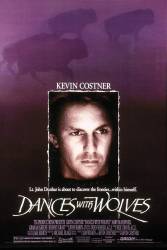Continuity mistake: The Civil War battle scene has trees already turning fall colors, and the cornfield is already showing frost damage with dying top leaves. The likely timing for scenery such as this would be about mid to late September. There wouldn't be enough time for Dunbar's leg to heal, then travel 1000 miles west, then establish rapport with the Sioux, then go on a buffalo hunt, then move to winter quarters before snow flies.
Suggested correction: Maybe he recovered over fall and winter, then traveled west in spring?
Dunbar tells the Army soldiers that have him captured that he arrived at the fort in April.
Corrected entry: When Timmons is shot by the Pawnee, the arrows disappear from his wounds as he crawls around on the ground.
Correction: Timmons is shown staggering around on foot, with arrows visible in him. He is never shown crawling, and the arrows never disappear.
I just watched this scene, there's a shot following the departing Pawnee that lingers on Timmons' supine (and scalped) body, and the three arrows that had been lodged in his chest and stomach are indeed missing.
The arrows would be missing at this point because the Indian would have retrieved them.
Corrected entry: After unloading the supplies at Fort Sedgewick, when Lt. Dunbar hands Timmons a case of supplies just before he leaves, there is only one wagon hitched up. In the following shot Timmons pulls away with two.
Correction: There is a second wagon hitched, but it can only be seen momentarily before Timmons begins riding away. No mistake here.
Timmons has 2 wagons back-to-back when they are going through the dry river bed, also as leaving Ft. Sedgwick he is still towing a second wagon behind the first one.
Correction: In earlier scenes as they leave Ft Hayes, come across the skeletal remains, and then make camp for the night, two wagons hitched together pulled by a 6 mule team are seen.
Corrected entry: When Dunbar is riding into the village to talk with Stands With A Fist, Wind In His Hair (appearing immediately to the left of Dunbar) is wearing Dunbar's Lieutenant dress jacket, which Dunbar does not give to Wind In His Hair until well after this scene takes place. (01:35:10)
Correction: Wind in His Hair is wearing 'a' soldier's jacket - not necessarily Dunbar's jacket. Native Americans would often take spoils from raids - as trophies - including (and especially) the uniforms of soldiers they had killed.
Correct - he got it off another soldier.
Correction: When John Dunbar first walks into the abandoned soldiers' fort, a soldier's jacket is hanging. It's possible that other jackets were there and possibly taken as a trophy after the fort was abandoned.
Question: Why did Dunbar's superior kill himself as Dunbar was being taken to his new post?
Answer: He was mentally disturbed and was depressed about being assigned to a "dead end" post with no chance at advancement. Dunbar, the hero, choosing to be assigned to the frontier, just pushed the poor soul over the edge.
In a word, the disease syphilis. The urinary tract problems and the Insanity are possible side effects.
What are you basing this on? What in the movie indicates that he has syphilis?
Answer: Dunbar's superior supported the British ("The King is dead... Long live the King" said with a heavy British accent) and was likely a closet-case Redcoat his entire US military career. It was not rare and many suicides were a result of that.
This claim is not supported by the movie. "The King is dead. Long live the King" is a common idiom referring to the passing of power to someone new. It most definitely does not literally refer to the English King. The movie is set in the middle of Queen Victoria's reign. As for your assertion that there were a large number of English loyalists in the Union Army three generations after the Revolutionary War seems highly unlikely. Can you cite evidence of this?
Corrected entry: When Sergeant Pepper reloads his musket and talks about settling the whole business with high stakes poker, he pours powder down the muzzle and then proceeds to ram the rod down but without having placed any bullet (buckshot) inside the barrel. The purpose of the rod is to ram the buckshot all the way down to get it seated on the powder. (00:07:05)
Correction: Wouldn't be buckshot, it would be a minie ball. The bullet would be in the paper cartridge. No, he is not out of bullets and just firing blanks.
So he tears the wrapper, pours the powder down the barrel, throws the wrapper containing the bullet away and then rams the powder. He never put anything other than powder in the barrel. But then, this being a movie set, he would only have the supplies to load blank.
Correction: It's possible he's out of bullets and trying to simply scare the Confederates.
Or the bullet was a part of the powder pack.





